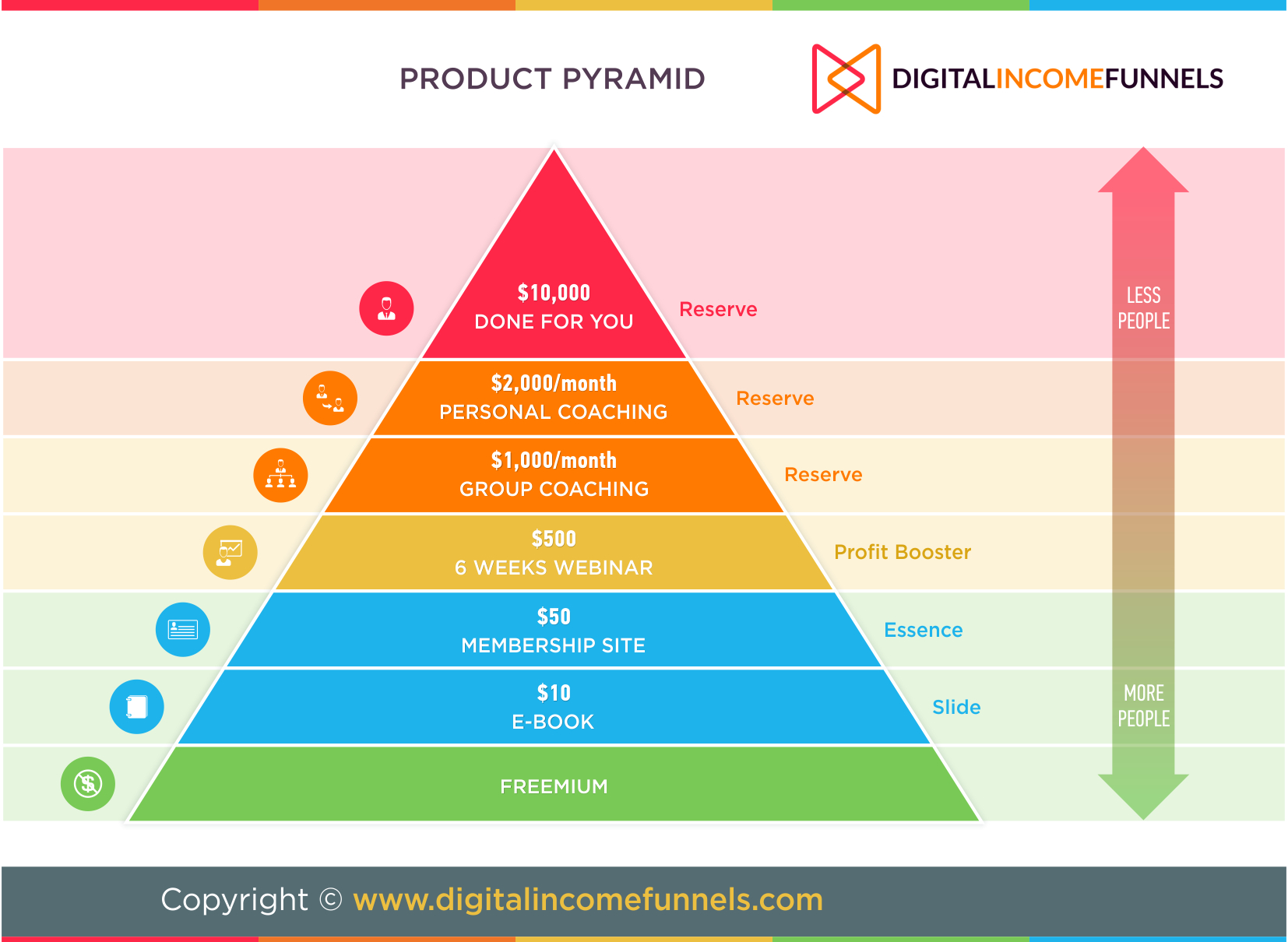[thrive_text_block color=”note” headline=””]
Want to know how to collect payments even before you create your digital product? I’ve created a 2-page pdf to show you how.
PLUS you get to get the pdf version of this blog post as well so that you can refer to it anytime you like, even when you’re offline.
Click here now to get both FREE.
[/thrive_text_block]
This post is about how to create a digital product. Follow the guidelines below and you’ll be on your way to creating a digital product that people actually want to pay money for.
Digital Products Pros Over Physical Products
The advantages of selling digital or information products (ebooks, reports, audios, videos, software, apps) are:
- You leverage time (more of this in a bit)
- There is no manufacturing cost
- There is no shipping cost
- There is no inventory cost (only server cost which is very affordable)
All of these mean there is a very high profit margin.
And creating a digital product doesn’t have to be hard, but it’s not easy either. It’s a simple system to follow, but it’s not easy.
Anybody can just come in and create a digital product.
But not everyone can create the RIGHT product that people actually want to pay money for.
I mentioned leveraging time in the beginning of this post.
What does that mean?
It means once your digital product is created, you can sell it over and over and over again. Create the product once and sell it for a long time, especially if your product is on an evergreen topic.
Time, unlike money, once spent — can’t be gotten back.
Here’s a quote I really like from best-selling pastor author Rick Warren:

10,000 Punches VS 10,000 Times

Who do you think get paid more? Primary care physicians or specialist doctors?
[thrive_text_block color=”note” headline=”What You’ll Learn”]
After you’ve finished this post, you’re going to uncover tips and strategies to increase your digital products success (i.e. selling a ton of copies) before you even start creating them.
[/thrive_text_block]
According to Forbes:
[pullquote align=”normal”]Specialists still far out produced their primary care counterparts in terms of guarantees offered by an average of over $150,000.[/pullquote]
Suppose you want to seek the advice and guidance regarding Facebook ads. Who do you approach?
Someone who is a general social media expert (he can do Facebook ads, LinkedIn, Twitter, Pinterest, Instagram) or someone like Jon Loomer who is widely recognized as a Facebook ads expert?
[thrive_text_block color=”note” headline=””]
It’s better to target a smaller portion of your niche. We call it the sub-niche.
[/thrive_text_block]
Shopify is for people who want to open an online store selling physical products.
Zaxaa is a sales funnel shopping cart platform for digital product creators who want to:
- Sell simple one-off digital products
- Set up simple and complicated sales funnels / CVM
- Leverage the use of a CRM tool to build relationships with customers and leads via smart email marketing (if-then rules and tagging) or via simple traditional email marketing (user can choose however they want)
Bruce Lee shared the same opinion:
The health and fitness niche is very broad. Clickbank.com has divided it into these sub-categories:
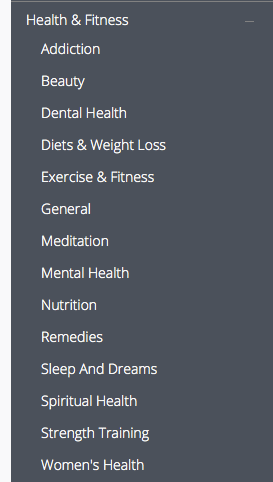
Inside the Health & Fitness niche >> Diets & Weight Loss sub-niche >> we can even break it down further to:
- Weight loss diet
- Weight loss pills
- Weight loss surgery
- Weight loss exercise
- Weight loss juice
We can take away weight loss surgery and pills because they wouldn’t make sense to digital product creators.
People looking for surgery will just want to have a surgeon perform it and be done with it, whereas those looking for pills want to just buy the bills and consume it — there’s nothing to learn.
You can even go deeper and become more specific, e.g — you’re a weight loss coach who specialize in helping moms lose weight via natural weight loss (without any pills).
Yes your target audience size will shrink, but so does the competition.
It’s easier and quicker to make an impact in a smaller, tighter niche because your message will be super laser-targeted to your perfect customers.
[bctt tweet=” It’s easier and quicker to make an impact in a smaller, tighter niche. Here’s why…”]
Further Validating Your Product Idea & Topics

Now that you understand the advantages of selling a digital product and that you should aim for a sub-niche within your market, the next step is to actually create one right?
Wrong.
If you want to successfully run a thriving information business for the long term, you need to think strategically and begin with the end in mind.
You first need to understand these steps first before actually creating your product:
- The principles of Customer Value Maximization (CVM)
- Creating a Freemium / lead magnet
- Creating a high converting lead capture page to give away your Freemium
Especially step #2… where you’ll understand the pain points your perfect customers want to solve and also do the “reverse CVM / sales funnel” exercise… which will force you to really think hard about the types of products and/or services you want to offer.
If you do this, you’re already way ahead of your competition because almost everyone would be creating their products one at a time without strategically thinking about the bigger picture.
You think in terms of Customer Value Maximization (CVM) as a whole while they think in terms of bits and fragments (a single product and the next single product, and so on).
[bctt tweet=”Unsuccessful digital product creators think of 1 product at a time while the successful think in terms of CVM”]
Now that you know the problems your perfect customers are facing, you have a basic framework of what to cover in your product portfolio.
Here’s how to take it a step further to make sure your product is a roaring success.
Go over to Amazon.com and do a search for your topic:

Search the results by “most reviews”, and then go through the list to find books that are relevant to what you’re searching for.
Click on the first result in this example, and then click the “look inside” feature:
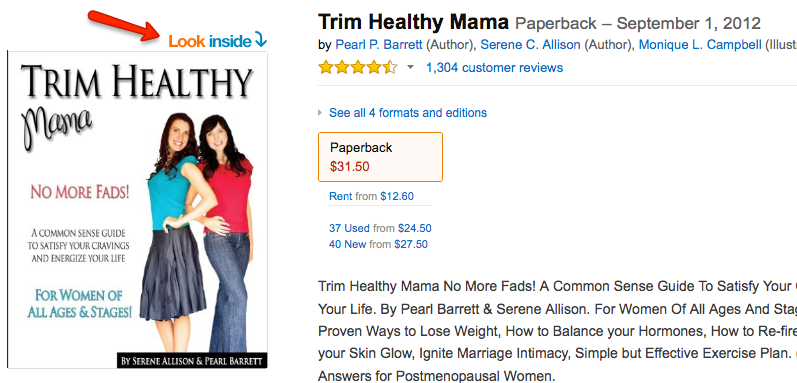
Click “Table of Contents”:

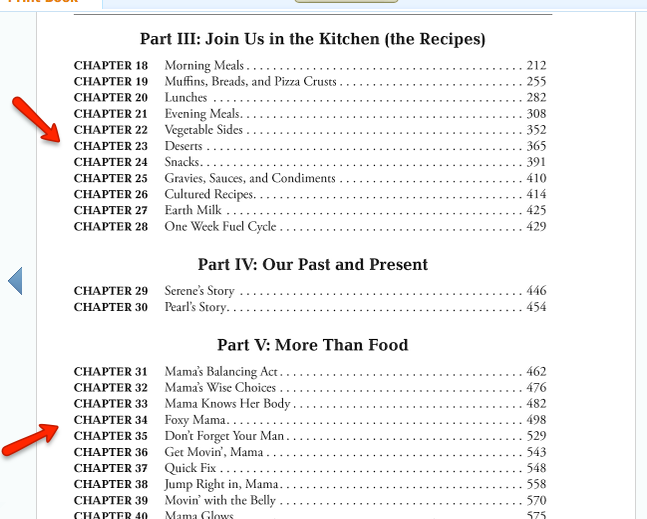
This will give you more ideas and open your eyes to topics to cover that might not have crossed your mind before.
After you’re done with taking down notes for possible topics inclusion, close the table of contents and scroll down to the comments section and click “see all 1,304 reviews”:
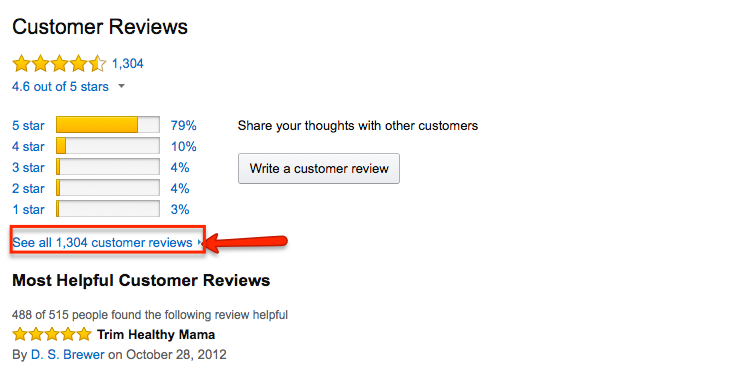
These are user reviews from real people… the kind of people who are your target audience. Pay attention to how they express their emotions and comments. These are real customer language that you can echo back in your sales copy.
Think about it… if someone takes their time to write a review — regardless of whether it’s a good or bad review — don’t you think these people are enthusiastic and passionate about the topic?
The longer the review, the more passionate and fanatic the reviewer is.
You can read through the good reviews, but pay special attention to the “critical and most helpful” reviews.
You can also filter the results to only show reviews by verified buyers only, to weed out potential sabotage by competitors:

These critical and most helpful reviews contain information that the current book is not fulfilling. Your job, then, is to cover what the book failed to touch upon and create a better and more complete product.
What better way to uncover real customer language (both complaints, and praises) than to hear them directly from customers.
[bctt tweet=”This is how you uncover real customer language (complains and praises) without talking to them face-to-face”]
Ensuring People Want To Pay Money For Your Product Before You Create It

Even though you’ve already done quite a lot of research about the topics to cover in your product…
Wouldn’t it be more awesome if you have a way to make sure people actually want to pay money before you actually create your product?
Here’s how you do it…
Drive traffic to your lead capture page offering your Freemium / lead magnet. After people optin, redirect them to a landing page where you explain if they want to get a more detailed version of the Freemium, they can get your paid product at a huge discount.
Say something like this:
[pullquote align=”normal”]Thank you for requesting the “5 ways to lose weight naturally for moms” report. I’m currently working on a more detailed video course that’ll help moms like you lose weight even faster, and it’ll be finished soon.
If you’re interested in getting this video course at 50% discount when it’s ready, enter your email below to be added to the priority discount list. [/pullquote]
Meanwhile, you also link over to this landing page from inside your Freemium as well as inside your email sequence.
This way you have multiple opportunities to remind them about your video course offer. People are busy and tend to forget, so it’s always a good thing to remind them.
[bctt tweet=”How to make sure people are willing to pay money for your digital product before you create it”]
[thrive_text_block color=”red” headline=”*** How To Collect Payments Even Before You Create Your Product ***”]
I’ve created a 2-page pdf to show you how.
PLUS you get to get the pdf version of this blog post as well so that you can refer to it anytime you like, even when you’re offline.
Click here now to get both FREE.
[/thrive_text_block]
Types Of Products You Can Create

Revisit this post about the different types of Freemiums / lead magnets you can create. The same type applies to your paid products as well.
You could create one or more or a combination of:
- Report / white paper / ebook / case study
- Podcast / audio mp3
- Video / webinars
- Cheatsheet
- Infographic
- Checklist
- Resource list
- Templates
There are certain types that have a higher perceived value in the eyes of customers and hence are generally more expensive than others.
For example, video > (is more expensive than) audio > (is more expensive) written text (ebooks and reports).
Even if you’re offering only an ebook, don’t just call it an ebook. The perceived value for an ebook is low. Instead call it a training program or home study course, etc.
You can’t make a lot of money by selling only 1 product, which is why you must employ the Customer Value Maximization (CVM) strategy in your business.
[bctt tweet=” You can’t make a lot of money by selling only 1 product, which is why you must employ the CVM strategy”]
You want to have something like this:
You create products that all tightly related to one another — which is another reason why you go into a sub-niche rather than the main niche. If you go into a sub-niche, you’ll inevitably create products that are more relevant to one another.
It’s definitely a lot easier to sell your products when your product portfolio consists of offers that are all closely related.
As your offers get more expensive, you’ll get less and less customers. 80/20 says that only a small portion of your audience will purchase your most expensive offers.
It’ll look something like this:
| # Customers | Product Price | Revenue |
| 5000 | $10 | $50,000 |
| 1000 | $50 | $50,000 |
| 200 | $500 | $100,000 |
| 40 | $1,000 | $4,000 |
| 8 | $2,000 | $16,000 |
| 1 | $10,000 | $10,000 |
Although the types of products (ebook / audio / video) have an influence over how much you can charge for your products, a more important factor is to charge based on how much value it delivers to your customers.
And you should also never based on how long it took you to create or how long the ebook or video is. Nobody cares how long it took you to create.
[bctt tweet=”Price your product based on how much value it delivers, not how long it took you to create”]
[thrive_text_block color=”note” headline=””]
Your customers only care what your product can do for them… how it can solve their problems and pain points and make their lives easier.
[/thrive_text_block]
How To Sell Higher Ticket Products

When Noah Kagan, founder of AppSumo, tried to sell a $300 digital product, he thought it would be an easy sell. Boy was he wrong. Having been used to sell $49 products, sales for his $300 flop.
This article explains the whole story and also contains some great tips on how you can sell more digital products effectively at a higher price point.
It makes perfect sense if you think about it.
Impulse purchases at a low price don’t require much back and forth thinking.
Higher prices, though, require that you prove you know what you’re talking about (expert and authority) and that you’re not just another “pushy salesman” who only want their money.
This is why reengagement (the 5th stage in the CVM process) is so important to close the sale. Since you already have subscribers and customers contact info when you give away your Freemium (1st CVM stage), you can follow up with them using emails (in the order below) to:
- Provide value by giving them useful tips and strategies
- Build and nurture relationships
- Build trust
- And eventually sell your paid offers
Instantly Boost Sales

I’ve mentioned this earlier, but I’m going to reiterate.
You do know that humans LOVE discounts right?
The thought of missing out on a good discount deal is simply too irresistible and painful.
Knowing this, you must make your discount limited and scarce. Since you’re selling digital products, a deadline would be a good scarcity.
After your product is ready for launch or during special occasions (your birthday, your business anniversary, customer appreciation day, Thanksgiving, Christmas, etc), you could give a 50% discount for the first 7 days, for example.
Here’s a 3-day discount we ran some time ago for one of our offers (using Zaxaa):

Sales shot through the roof compared to regular days when there is no discount.
With Zaxaa, it’s easy and quick to set up limited-time or limited-quantity discounts, with customized coupon codes too — e.g. my30thbirthday, yourock, thanksgiving, etc.
IMPORTANT — make sure the scarcity deadline is real — meaning if you say the discount is only valid till a certain day, keep your word. Otherwise, buyers who have purchased during the discount will get upset and those who haven’t purchased realized that you’re just trying to cheat them in a desperate attempt to increase sales.
You lose credibility and reputation. The next time you run another scarcity offer, people won’t believe you anymore.
[bctt tweet=”This is how you instantly 3x sales with no extra effort”]
Influencing A Person’s Buying Decision Via A Decoy Effect

There is another way to increase your sales… via a decoy effect.
The best example I’ve seen with regards to explaining what a decoy effect is via the National Geographic video below:
[responsive_video type=’youtube’ hide_related=’1′ hide_logo=’1′ hide_controls=’0′ hide_title=’1′ hide_fullscreen=’0′ autoplay=’0′]https://www.youtube.com/watch?v=wxXwsCmWakM[/responsive_video]
Without the medium popcorn, most people would choose the small one. But when you add in the medium popcorn, the large popcorn suddenly seems to be a much better value.
Here’s another example of a decoy effect used in The Economist subscription plans:

This time the decoy effect is used a little more extreme — 2 out of the 3 plans were cleverly priced at the same price. It doesn’t make sense not to choose the print + digital option right?
Using the earlier example of a coach teaching moms how to lose weight naturally, you could package your video course like this:
| Silver ($100) | Platinum ($300) |
| Video course only | Video course + transcriptions + cheatsheets + 6 weeks group coaching |
At 3x the price, how many do you think would take the Platinum package?
Now compare this:
| Silver ($100) | Gold ($290) | Platinum ($300) |
| Video course only | Video course + transcriptions + cheatsheets | Video course + transcriptions + cheatsheets + 6 weeks group coaching |
Wouldn’t you agree the Platinum package suddenly now seems a much more attractive package compared to before?
Most likely, you won’t even sell a single unit of Gold… but you don’t care. It’s just there as a decoy effect — to make Platinum so enticing that people drool. The goal from the very beginning was to sell Platinum.
The decoy effect works when you have 3 options available for your product, no more and no less. And the whole idea is to make one of the plans look so much more valuable than the other two that it would be stupid not to take up the plan.
How to Apply This To Your Business
Now that you know how to create a digital product that people want to pay money for, go follow the steps below:
- Target a sub-niche within your niche and become a specialist
- Revisit your research about the problems and pain points your customers want to solve
- Mine that down further by going to Amazon to:
- Uncover more potential topic ideas to cover for your products
- Discover gaps that are not being met / solved even by best-seller books — this is your golden opportunity to touch upon these gaps in your products
- Capturing real customer language (both positive and negative) and echoing back them “exactly as they are” on your sales materials
- Reengage with customers and leads (subscribers) to sell more of your products, especially higher-priced products (BirdSend can do this easily and quickly)
- Boost your sales with a limited-time or limited-quantity discount, especially when launching a new product or during special occasions (Zaxaa can do this)
- Influence your customers’ purchase behavior through the use of a decoy effect
Your Turn
Tell me in a comment below what niche or sub-niche you’re in. If you’re in a main niche, tell me how you plan to move into a sub-niche. Also let me know if you have any questions. I personally read each and every question.
If you find this post useful, I’m sure others will as well. Can I ask a favor and ask you to share it with your friends by clicking one of the share buttons below? Thank you in advance!
[thrive_text_block color=”purple” headline=”*** How To Collect Payments Even Before You Create Your Product ***”]
I’ve created a 2-page pdf to show you how.
PLUS you get to get the pdf version of this blog post as well so that you can refer to it anytime you like, even when you’re offline.
Click here now to get both FREE.
[/thrive_text_block]


